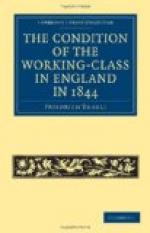looking down from Ducie Bridge, the passer-by sees
several ruined walls and heaps of debris with some
newer houses. The view from this bridge, mercifully
concealed from mortals of small stature by a parapet
as high as a man, is characteristic for the whole
district. At the bottom flows, or rather stagnates,
the Irk, a narrow, coal-black, foul-smelling stream,
full of debris and refuse, which it deposits on the
shallower right bank. In dry weather, a long
string of the most disgusting, blackish-green, slime
pools are left standing on this bank, from the depths
of which bubbles of miasmatic gas constantly arise
and give forth a stench unendurable even on the bridge
forty or fifty feet above the surface of the stream.
But besides this, the stream itself is checked every
few paces by high weirs, behind which slime and refuse
accumulate and rot in thick masses. Above the
bridge are tanneries, bonemills, and gasworks, from
which all drains and refuse find their way into the
Irk, which receives further the contents of all the
neighbouring sewers and privies. It may be easily
imagined, therefore, what sort of residue the stream
deposits. Below the bridge you look upon the
piles of debris, the refuse, filth, and offal from
the courts on the steep left bank; here each house
is packed close behind its neighbour and a piece of
each is visible, all black, smoky, crumbling, ancient,
with broken panes and window frames. The background
is furnished by old barrack-like factory buildings.
On the lower right bank stands a long row of houses
and mills; the second house being a ruin without a
roof, piled with debris; the third stands so low that
the lowest floor is uninhabitable, and therefore without
windows or doors. Here the background embraces
the pauper burial-ground, the station of the Liverpool
and Leeds railway, and, in the rear of this, the Workhouse,
the “Poor-Law Bastille” of Manchester,
which, like a citadel, looks threateningly down from
behind its high walls and parapets on the hilltop,
upon the working-people’s quarter below.
Above Ducie Bridge, the left bank grows more flat
and the right bank steeper, but the condition of the
dwellings on both banks grows worse rather than better.
He who turns to the left here from the main street,
Long Millgate, is lost; he wanders from one court to
another, turns countless corners, passes nothing but
narrow, filthy nooks and alleys, until after a few
minutes he has lost all clue, and knows not whither
to turn. Everywhere half or wholly ruined buildings,
some of them actually uninhabited, which means a great
deal here; rarely a wooden or stone floor to be seen
in the houses, almost uniformly broken, ill-fitting
windows and doors, and a state of filth! Everywhere
heaps of debris, refuse, and offal; standing pools
for gutters, and a stench which alone would make it
impossible for a human being in any degree civilised
to live in such a district. The newly-built
extension of the Leeds railway, which crosses the




